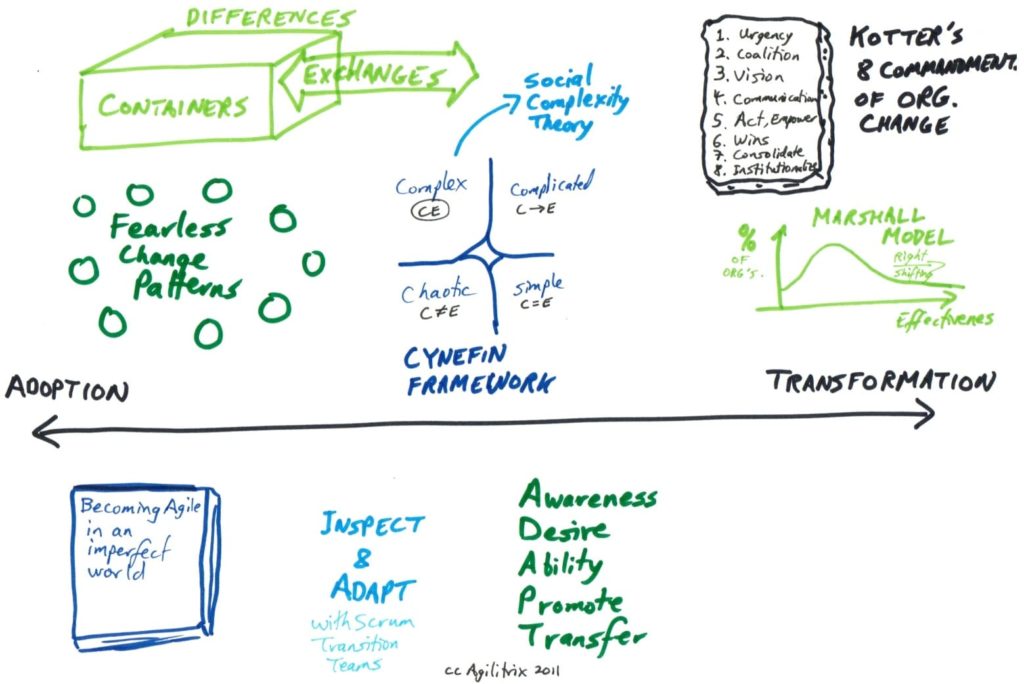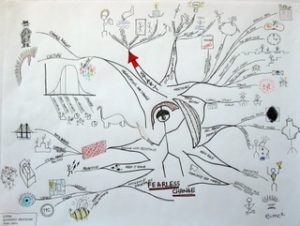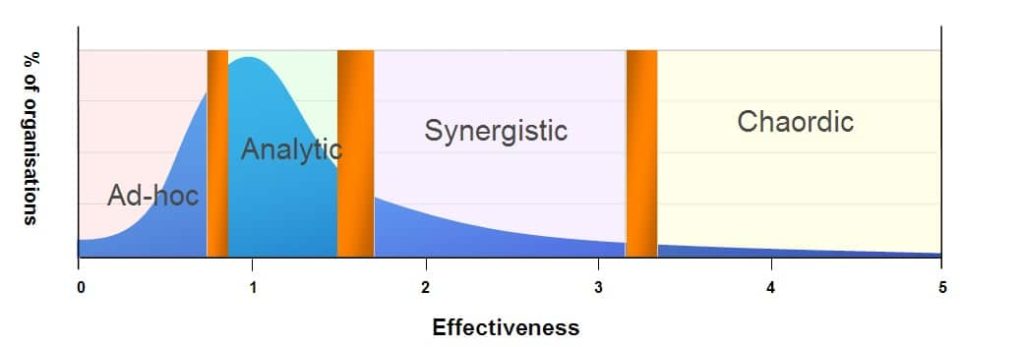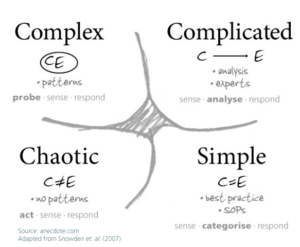In light of Agile adoption failures and awareness of cultural challenges, the purpose of this post is to review current models that are applied to Agile Adoption and Agile Transformation with Agile at organizations. Worthy background reading is Mike Cottmeyer’s post on Untangling Adoption and Transformation.
It is worth noting that there is no widespread agreement about how to undertake agile adoption.
A Tour of Adoption and Transformation Models
Below a number of models for Agile adoption and organizational transformation are shown.
The horizontal scale shows on the one hand techniques aimed at adopting practices while at the other we have wholesale organizational change or transformation. I am increasingly thinking that for many situations, adoption is not sufficient and transformation is required but not wanted.
Models above the line are not specific to Agile, while those below the line come from an Agile context.

What follows is a short overview of each model or approach.
Becoming Agile in an Imperfect World
 Smith and Sidky’s book – Becoming Agile in an Imperfect World – provides a lot of practical advice on adopting Agile. They begin with the premise that many companies are not ready for Agile along a variety of dimensions: Tools, Culture, Project Management, Software Process and Physical Environment. They advocate becoming as Agile as possible given the current environmental limitations and most important needs. Although they recognize that Agile represents a shift in thinking, they support an incremental practices-oriented adoption. Some might characterize this as Doing Agile rather than Being Agile.
Smith and Sidky’s book – Becoming Agile in an Imperfect World – provides a lot of practical advice on adopting Agile. They begin with the premise that many companies are not ready for Agile along a variety of dimensions: Tools, Culture, Project Management, Software Process and Physical Environment. They advocate becoming as Agile as possible given the current environmental limitations and most important needs. Although they recognize that Agile represents a shift in thinking, they support an incremental practices-oriented adoption. Some might characterize this as Doing Agile rather than Being Agile.
Containers, Differences and Exchanges
The CDE (Containers, Differences, Exchanges) model provides a way to understand the context of a team or group and highlights ways of effecting change. For example, a team is a very powerful container for organizing staff. So is the physical environment. Esther Derby has a good post and presentation/video on Shifting Organizational Patterns. CDE is also discussed in Succeeding with Agile (p. 221-227).
Fearless Change
 Fearless Change: Patterns for Introducing New Ideas by Mary Lynn Manns and Linda Rising provides lots of great techniques and tips for adopting new ideas within an organization. The image at the right shows the different patterns (click for hi-res version). I have used these patterns and they are very helpful for adopting new ideas. I have included them on the adoption end of the scale as they are not about organizational transformation although they can support it.
Fearless Change: Patterns for Introducing New Ideas by Mary Lynn Manns and Linda Rising provides lots of great techniques and tips for adopting new ideas within an organization. The image at the right shows the different patterns (click for hi-res version). I have used these patterns and they are very helpful for adopting new ideas. I have included them on the adoption end of the scale as they are not about organizational transformation although they can support it.
Inspect and Adapt with Enterprise Transition Team
In The Enterprise and Scrum Ken Schwaber outlines his view of how to transition an organization to Scrum:
- Create an Enterprise Transition Team – a Scrum team responsible for the transition of the organization to Scrum.
- Apply Scrum to an enterprise backlog of transition items.
- Inspect and adapt to success.
Although there are a number of caveats – Scrum requires a new Enterprise Culture and huge effort to execute – the book is light on specifics.
Another example of this approach is written by Schwaber, Leffingwell and Smits: A CIO’s Playbook for Adopting the Scrum Method of Achieving Software Agility.
To my knowledge, this is the most commonly applied pattern within the community.
ADAPT
ADAPT is Mike Cohn’s model for adoption of Scrum:
- Awareness that the current process is not delivering acceptable results.
- Desire to adopt Scrum as a way to address current problems.
- Ability to succeed with Scrum.
- Promotion of Scrum through sharing experiences so that we remember and others can see our successes.
- Transfer of the implications of using Scrum throughout the company.
This feels like a light-weight version of the Kotter Model (below) for organizational change so I have placed it further along the scale towards transformation. See Chapter 2 of Mike Cohn’s Succeeding with Agile or presentation for further details.
Cynefin Framework
The Cynefin is a decision-making framework that recognizes the causal differences that exist between system types and proposes new approaches to decision-making in complex social environments. Some argue that the Cynefin model (Snowden) can be used for Agile adoption. Others use it as an analysis model to create a shared understanding of the type of environment so that the most appropriate approach can be selected. For example, for complex environments, cause and effect are so closely linked that an adaptive approach to change is appropriate.
Here is a short video explanation of the Cynefin model as well as a presentation on why it matters. i.e. the case for Complex Adaptive Systems.
The implications for Agile adoption/transformation is clear – many organizational environments are complex and adoption approach needs to reflect this. In this case, we will not know what actions will lead to the desired result. We can only take one and sense the result. This state implies less clarity than one would have with an Enterprise transition backlog.
Kotter Model for Organizational Change
Truly transforming an organization requires consistent sustained energy over a long period of time. Kotter outlines the 8 steps that need to happen in sequence to establish real and lasting change. These have been observed in a variety of companies over the last 20 years:
- Establish a Sense of Urgency
- Forming a powerful Guiding Coalition
- Creating a Vision
- Communicating the Vision
- Empowering Others to Act on the Vision
- Planning for and Creating Short-Term Wins
- Consolidating Improvements and Producing Still More Change
- Institutionalizing New Approaches
The model is simple, yet powerful and challenging. For example, the criteria put forth for a sense of urgency is that “75% of management genuinely believe that the status quo is unacceptable”. Another key aspect is that it is not possible to make real progress unless each step is completed in order.
Marshall Model of Organisational Evolution

At the very extreme edge of transformation, the Marshall Model defines a paradigm for organization evolution and growth. It can be viewed as an organizational maturity model where effectiveness increases with maturity. It reminds me of Spiral Dynamics Model that posits a theory of human development.
Conclusions
There are a lot of different ideas floating around of how to adopt and transform to Agile. The models presented here, together with your client’s situation, puts you in a better place to choose a suitable model to help them find success. Perhaps even asking yourself the question “Am I adopting Agile or transforming to Agile?” may help you find a happier path or terminate a painful one.
What’s Missing?
I am sure that you (the reader) have a story to tell about an approach to Agile Adoption or Organizational Transformation through Agile. Please comment and share.
2016 Update
In the five years since I wrote this, I look back here and see the seeds of my learning journey on how to help organizations grow and evolve. What models do I use?
- Cynefin – Understanding that we are working with a Complex System.
- Human Systems Dynamics (only CDE is listed above, not larger conceptual model).
- Awareness, Freedom & Choice – Understanding what is the will of the system and helping it make choices. Closest model to help understand this is TheoryU.
I have shared more details of my approach: My Journey: Agile, Culture & Transformation



